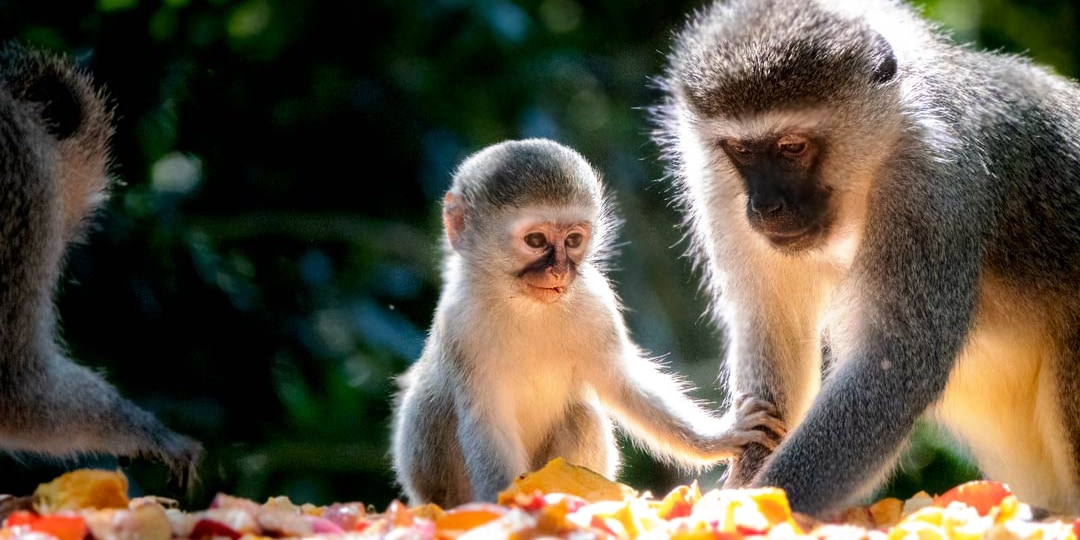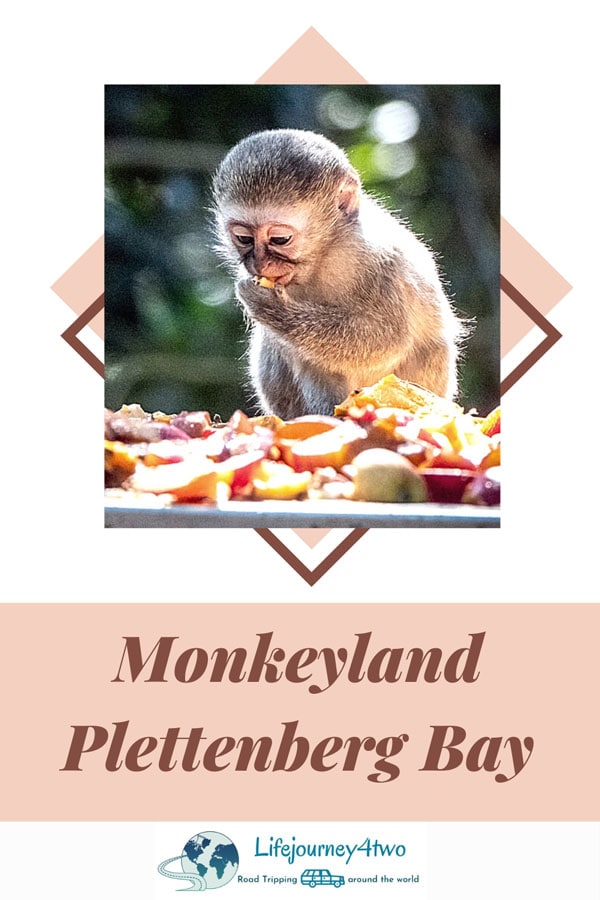Curious if Monkeyland Plettenberg Bay lives up to the hype?
As you wander just north of South Africa’s renowned Garden Route, a symphony of ‘Whoops’ echoes through the treetops at Monkeyland Plettenberg Bay.
Here, a diverse group of primates—from swinging spider monkeys to solemn sakis—thrives in what’s been crafted as their safe “forever home.”
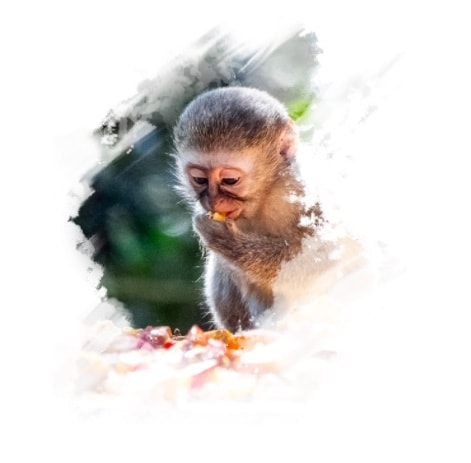
While the lively antics of these forest dwellers are a draw, many wonder if a visit to this sanctuary truly offers a unique and valuable experience.
In this post, we delve into what makes Monkeyland special and whether it stands out as a must-visit destination along the picturesque Garden Route
Quick Overview: Monkeyland Plettenberg Bay
Quick Overview:
- Location: Just north of the Garden Route, The Crags, Plettenberg Bay.
- Hours: 8:00 AM to 5:00 PM daily.
- Tickets: Adults R380, Children R190. Discounts for families/groups and combo tickets. Purchase at the entrance; no pre-booking required.
- Tour Duration: About 1 hour.
- Highlights: Over 550 primates, first multi-species free-roaming sanctuary, part of SAASA.
- Tips: Comfortable shoes, mosquito protection, and camera essentials.
- Is It Worth Visiting? It is perfect for wildlife enthusiasts and ethical tourists; read on for a detailed visitor experience review.
Is It Worth a Visit?
More than just observing, Monkeyland showcases a thriving model of ethical animal treatment and conservation. Ideal for those passionate about wildlife or looking for a truly meaningful day out, it offers an insightful look into efforts to amend the misdeeds done to these intelligent beings.
Read on for a detailed visitor experience review.
What Makes Monkeyland Unique?
Monkeyland stands out not just as a sanctuary but as a pioneer in primate welfare. Established in 1998 in the lush Crags of Plettenberg Bay, it provides a freedom haven for over 550 ex-captive primates.
It was the first sanctuary of its kind and now has a sister site, Monkeyland KZN, which opened in 2019.
Why It Matters:
Each resident shares a tale of resilience, from the playful squirrel monkey to the solemn black howler. Monkeyland offers a rare glimpse of these primates coexisting in natural social groups, showcasing a successful model of ethical wildlife conservation.
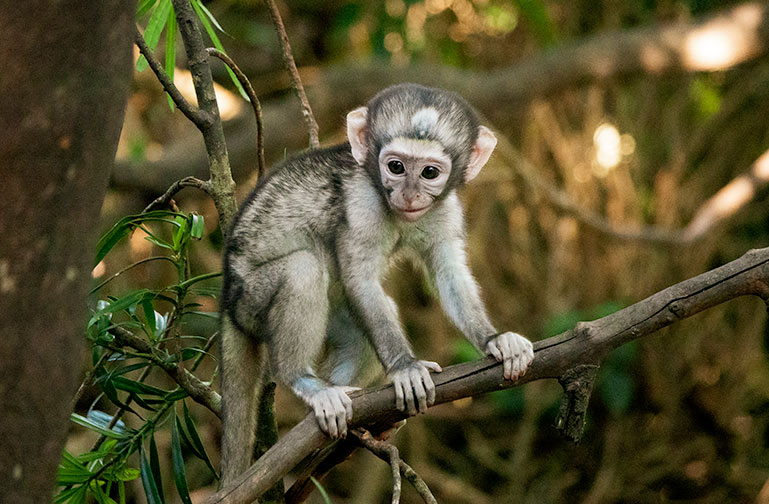
Planning a Trip to South Africa?
- 🚗 Hiring a car? We recommend getting a quote from DiscoverCars
- 🚐 Hiring a campervan? We recommend Motorhome Republic
- ⛑ Arranged your travel insurance? Compare quotes from World Nomads & Safetywing
- 🪪 Order your International Driver’s Licence online here
- 🏩 Booked your accommodation? We use Booking.com to find the best deals
- 🐾 Is someone pet-sitting for you? 🐾 We use and love TrustedHousesitters
- (Get 25% off at checkout for new memberships with our discount code: LIFEJOURNEY25)
Meet The Primates At Monkeyland Plettenberg Bay
Discover the ten unique species that call Monkeyland home. Each link below leads to a more detailed section about these fascinating primates.
- Ringtailed Lemur: Famous for their long, vividly striped tails.
- Ruffed Lemur: Known for their beautiful ruffed necks.
- Capuchin: Smart and curious, often seen using tools.
- Hanuman Langur: Revered in Indian culture, these langurs are graceful and agile.
- Squirrel Monkey: Small, quick, and incredibly agile.
- Howler Monkey: Their loud calls can be heard miles away.
- Vervet Monkey: Cute monkeys that are commonly seen throughout South Africa.
- Spider Monkey: Acrobatic primates that swing with ease.
- Bearded Saki: Unmistakable for their thick, bushy beards.
- Lar Gibbon: Also known as the white-handed gibbon, famous for their melodious duets.
We went around Monkeyland three times, and each visit brought a new experience. We saw every species, each with its unique charm. If not for the closing time, we’d have gone around again—we simply loved it!
Just so you know, we’re not affiliated with Monkeyland, and we paid for our tickets.
Monkeyland Plettenberg Bay Video
Take a quick look at our exclusive video tour below to get a real feel for what awaits you at Monkeyland.
From the playful antics of ringtailed lemurs to the calls of the Lar gibbons, this video offers a glimpse into the vibrant life within this unique sanctuary.
It’s the next best thing to being there in person!
Monkeyland and the South African Animal Sanctuary Alliance (SAASA)
Monkeyland isn’t just a sanctuary; it’s part of the award-winning South African Animal Sanctuary Alliance (SAASA), which champions the welfare of captive wildlife across South Africa.
This affiliation not only improves the lives of primates and other animals but also offers visitors a unique perspective on the importance and impact of ethical wildlife sanctuaries.
Why This Matters for Your Visit
- Educational Value: Being part of such a reputable alliance ensures that your visit is not only enjoyable but also informative. You gain insights into cutting-edge conservation efforts.
- Supporting a Good Cause: Your entry fees contribute directly to the well-being of the animals and support broader conservation efforts, adding a layer of purpose to your visit.
- Ethical Practices: A strict no-touch policy underscores Monkeyland’s commitment to animal rights, a practice that respects the natural behaviour of wildlife and ensures safe interaction for both visitors and animals. This approach is in line with global best practices in wildlife tourism.
Explore More Than Just Monkeyland
- Birds of Eden: Next door to Monkeyland, this sanctuary provides a seamless birdlife experience in its natural habitat, enhancing your understanding of biodiversity.
- Jukani Wildlife Sanctuary: A short drive away, Jukani offers a chance to see big cats in a respectful and ethical setting, rounding out a comprehensive visit to the area.
Get Involved If you’re moved by what you see, consider volunteering with primates or other wildlife. It’s a proactive way to contribute to conservation and makes your visit even more memorable.
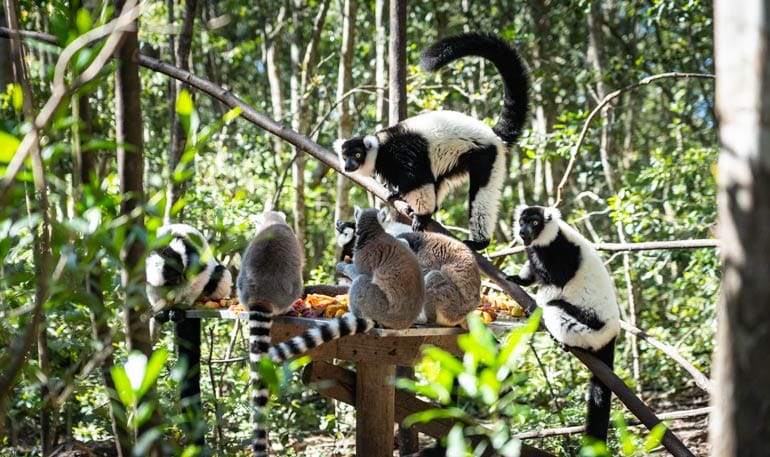
Where Do The Monkeyland Monkeys Come From?
Where Do The Monkeyland Monkeys Come From?
The monkeys at Monkeyland have each taken a unique journey to find sanctuary in this safe haven. Here’s a glimpse into their diverse backgrounds:
- Rescued Pets: Many were once household pets, a challenging situation for both the primates and their owners, who often don’t realize the complexity of caring for such intelligent creatures.
- Rescued from Cruelty: Some have been saved from dire conditions in private homes or abusive situations in circuses.
- From Science to Sanctuary: Others have been rescued from laboratories where they were used for research.
- Zoo Surplus: Additionally, a number come from zoos that could no longer care for them or had no space.
These backgrounds not only highlight the dire need for sanctuaries like Monkeyland but also enhance the educational aspect of your visit. Each monkey’s story is a lesson in wildlife conservation and the ethical treatment of animals.
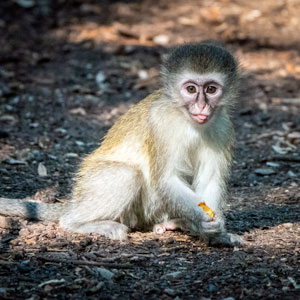
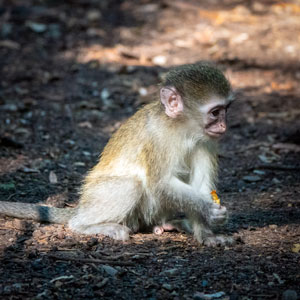

Baby Vervet Monkey in Monkeyland
What To Expect At Monkeyland Plettenberg Bay
Arriving at Monkeyland requires no pre-booking. Simply buy your ticket at the counter and wait in the restaurant, souvenir shop, or viewing platform for your guide.
Regular guided tours are available in multiple languages and usually start within 20 minutes. Before your one-hour Monkey Safari tour, you’ll be offered mosquito repellent. Use it generously—mosquitoes thrive in the forest’s dark, moist areas.
The tour allows you to get within arm’s length of these fascinating creatures. Guides provide insights into monkey personalities and behaviours, answering your questions.
To tackle the mosquito problem, Monkeyland has introduced repellent plants in the lily ponds and strategically placed plastic crocodile heads to deter monkeys from eating these plants.
Recommendations for Your Visit
- Dress Appropriately: Wear long sleeves and trousers to protect against mosquito bites.
- High-DEET Mosquito Repellent: Mosquitoes are a problem, so pay attention to this.
- Comfortable Footwear: You’ll walk through forest paths, so closed shoes would be good.
- Photography Tips: Bring a camera and check settings for variable lighting. Respectful distance is important. Read more here for safari photography tips.
- Full-Day Ticket: Your ticket allows you to participate in multiple tours.
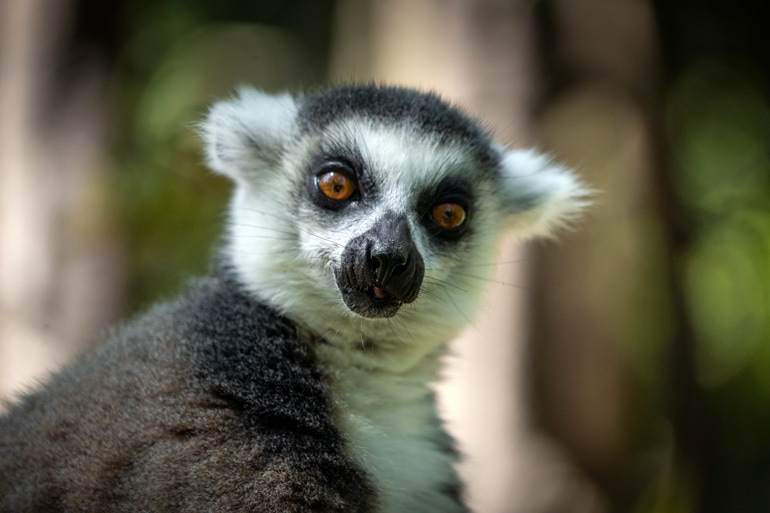
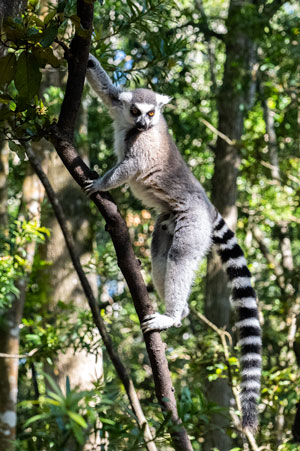
This little fellow, a ring-tailed lemur, struck a pose for the many eager cameras pointed his way. You’ll see him in our video and he seemed non-plussed by all the attention — as did most of the monkeys.
It was such a delight to be able to be a visitor in their environment and to be amongst them as they went about their daily lives.
Some of the monkeys were foraging for bugs on the ground. We caught the antics of one cheeky baby monkey speedily nabbing a juicy black beetle from his brother’s outstretched hand as he examined his catch.
There was lots of action as these primate cousins busied themselves around us. Baby monkeys clung to their mother’s fur while adolescents played rough and tumble and chased each other through the trees.
Many of the larger monkeys lazed around on branches while tiny squirrel monkeys and capuchins dashed between our feet, scooting to and fro in the undergrowth.

As well as walking through the forest, there are also a couple of large lily ponds and a 128-metre suspension bridge, which gives a contrasting perspective of an eye-level view across the treetops.
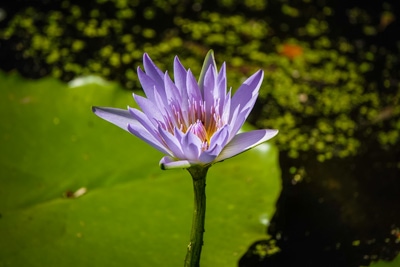

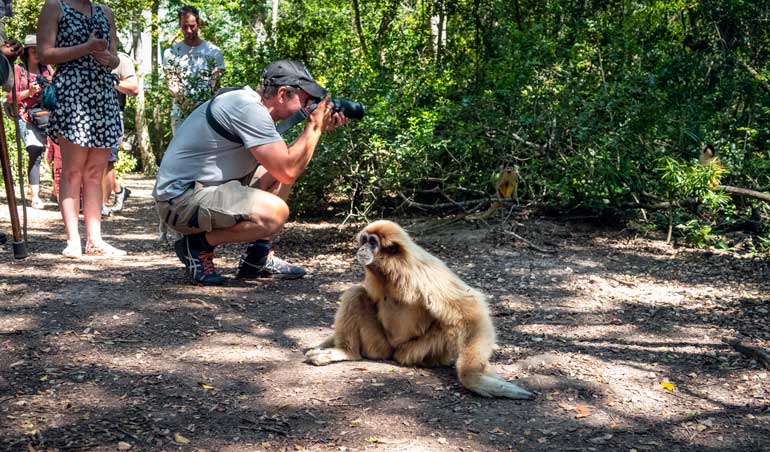
Visitor Reviews and Opinions
Curious about what others think of Monkeyland Plettenberg Bay?
Here are some highlights from TripAdvisor:
Clare Van Rensburg (May 2024, Family) Monkeyland is a true sanctuary. Our kids loved it, especially the White Handed Gibbons and Black Spider Monkey. Secure your belongings to avoid clever monkeys pinching them.
CelticChick52 (April 2024, Couples) Monkeys were everywhere! Applying mosquito repellent is a must. The guide was great at spotting and explaining the monkeys.
steviedownunda (April 2024, Melbourne, Australia) Magical experience with 600 monkeys of ten species. Worth donating to the 1m² fund to support the sanctuary.
Celeste V (February 2024, Family) Wonderful outdoor adventure. We saw many monkeys during feeding time. Perfect for animal lovers and families.
Justin P (April 2024, Schaffhausen, Switzerland) Amazing experience. Be prepared for mosquitoes with long pants and repellent.
Hilde (January 2024, Family) Disappointing visit due to rain. Saw very few monkeys. Check the weather before visiting.
The Monkeys At Monkeyland Plettenberg Bay
1. Black and White Ruffed Lemur
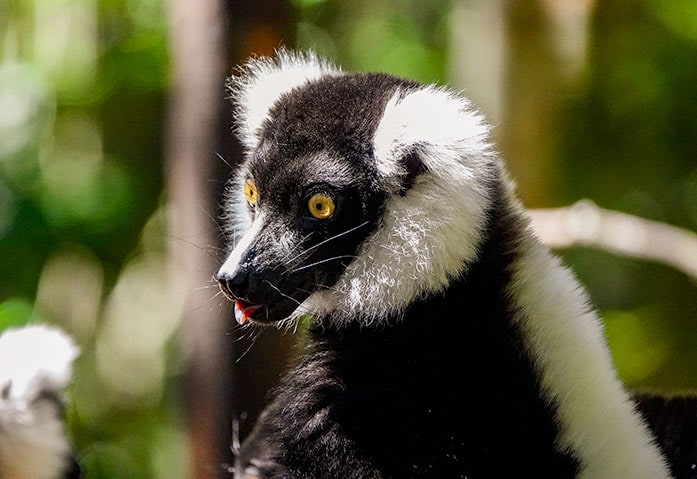
This white and black ruffed lemur is one of 103 species of Lemur.
Native to Madagascar, these lemurs are among the most endangered species due to habitat destruction the exotic pet trade and being hunted as bushmeat.
2. Ringtail Lemur
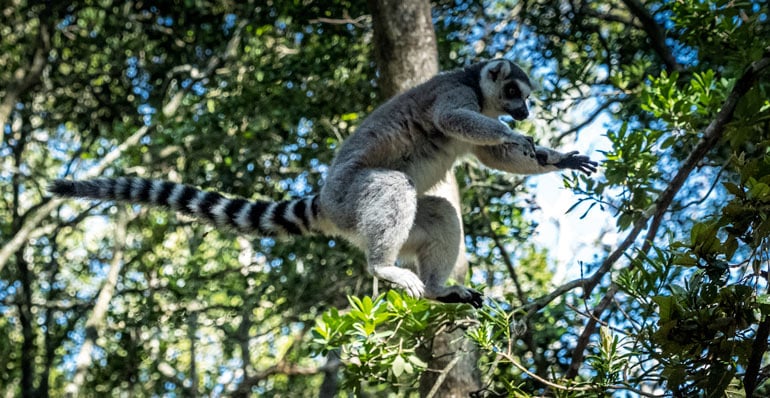
Easily recognized by their striped tails, these lemurs spend a lot of time on the ground foraging. The lemurs have cat-like facial features with whiskers and although they make a range of noises they can miaow and purr like a cat.
We came across several groups of them snuggled up together laying in the sun.
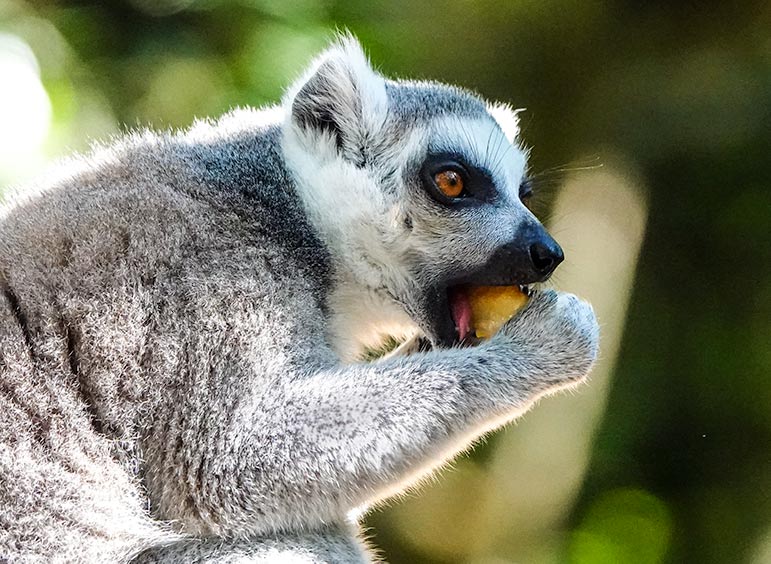
3. Black Howler Monkey

As their name suggests, the Howler monkeys are known for their loud howls, which can be heard up to five kilometres away.
Native to Central and Southern American rainforests, the males and females are different colours, with the males being black and the females a golden/brown colour. The young are born a blondie colour and change according to their gender.
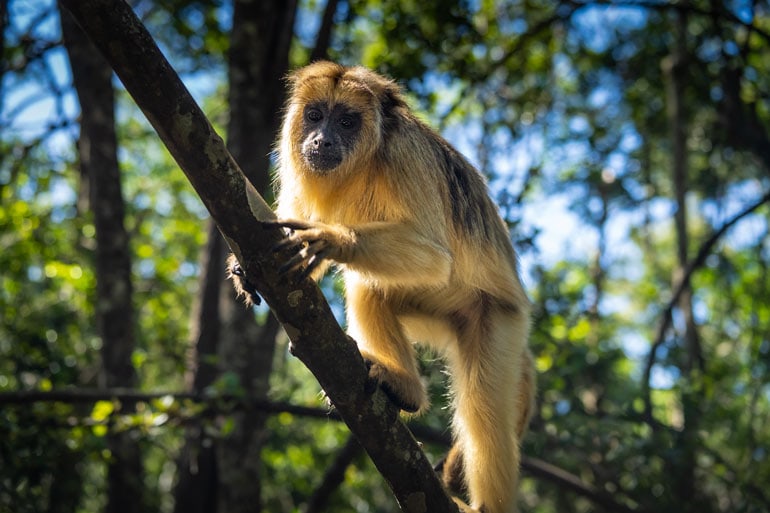
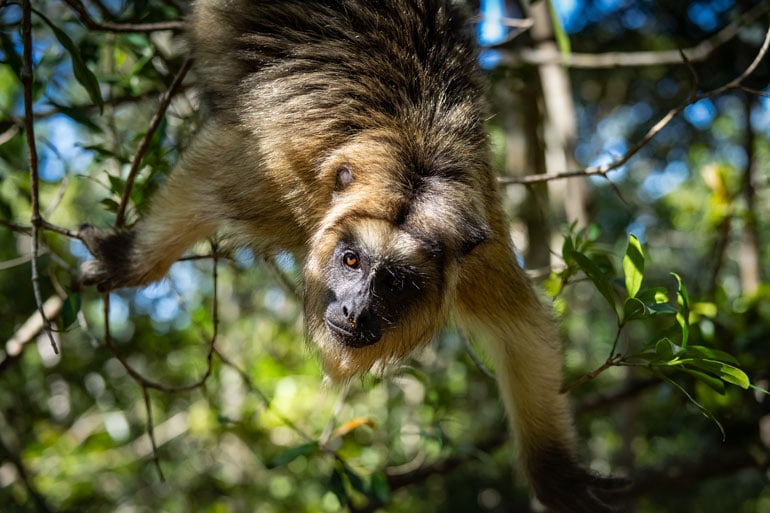
4. Bolivian Squirrel Monkey
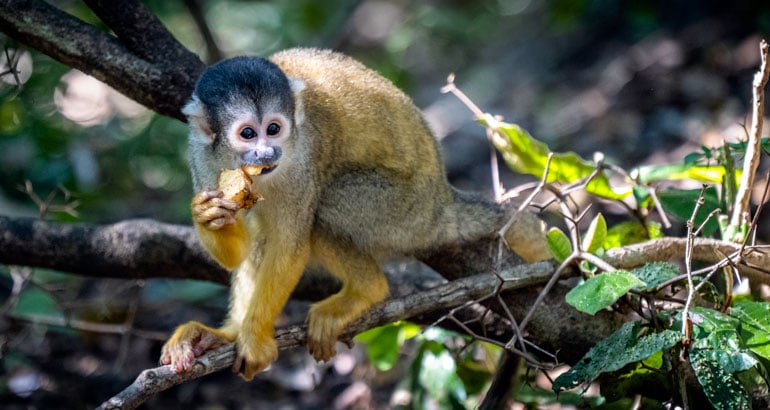
Despite their cute appearance, the squirrel monkeys are the most aggressive monkeys at Monkeyland.
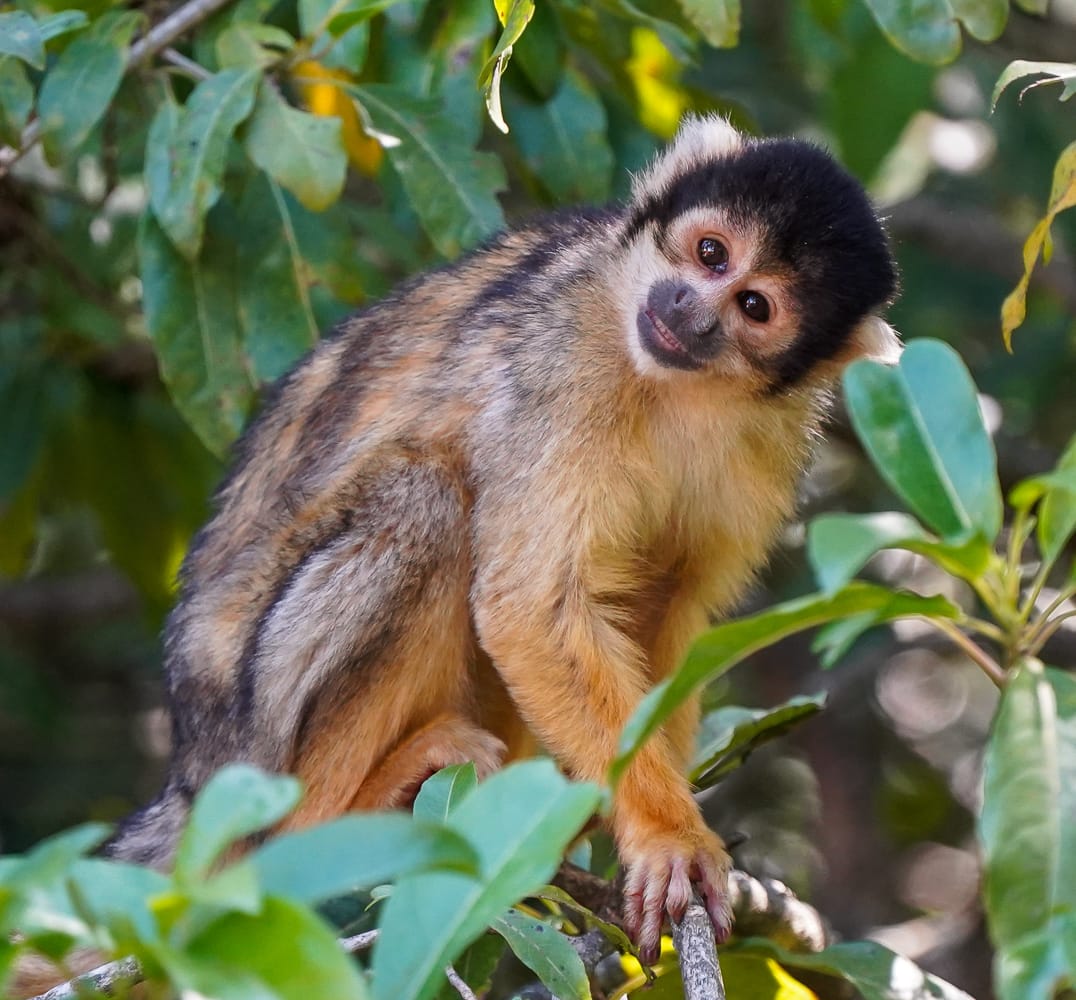
They are native to the Amazon Rainforests and are another endangered species, being threatened by use in biomedical research, monkey pet trade, bait and food.
Interestingly, the Squirrel Monkey’s brain-to-body mass ratio is 1:17, which gives it the proportionately largest brain of all primates. However, this doesn’t mean it is particularly smart.
5. Hanuman Langur
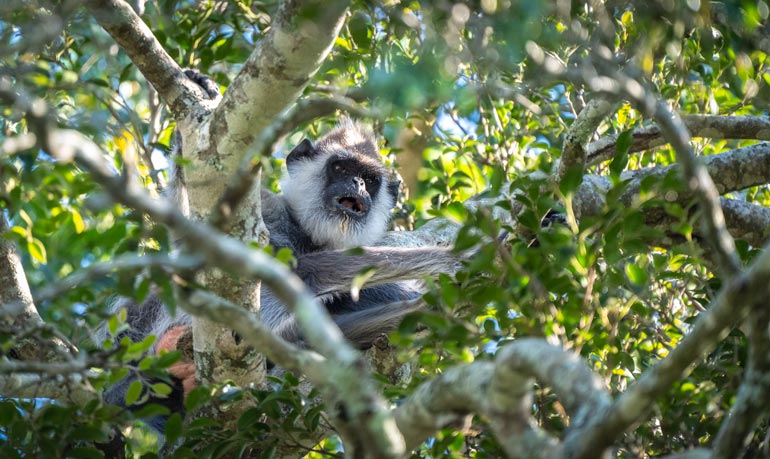
Native to India, these monkeys are known for their long eyelashes that protect against sun glare. The Hanuman’s name comes from a Hindu God, and this monkey is revered in some parts of India.
6. Geoffoy’s Spider Monkey
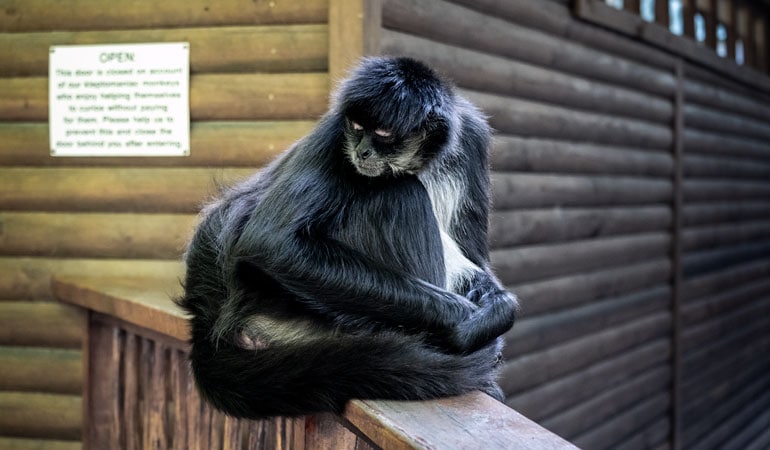
The spider monkeys, endangered due to deforestation, are known for their playful antics.
Lucy and her son Liam live in the Monkeyland forest and if you are lucky you’ll get to see these two characters. Lucy is getting old and apparently lacking patience but Liam is quite playful and we saw him pretending to take the guide’s stick.
7. Tufted or Brown Capuchin
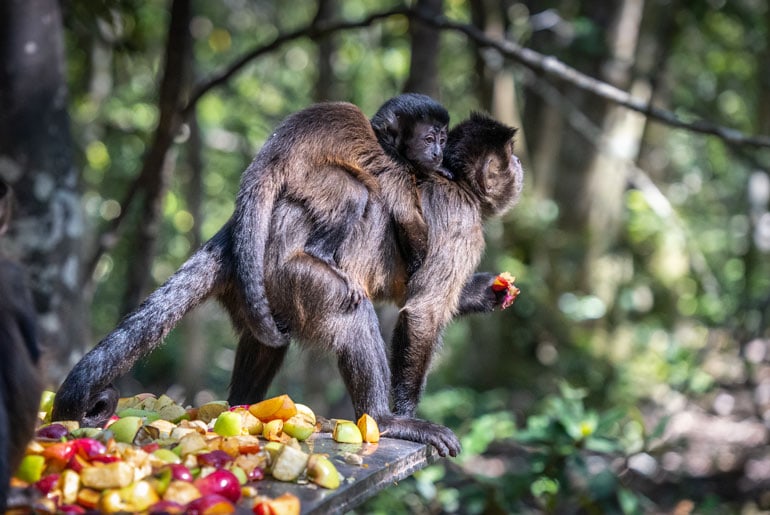
The Capuchin Monkey is recognisable by its brown ‘cap’ — and it is this which has resulted in its name. The brown cap resembles the hood of a Capuchin monk’s cloak.
The Capuchin use objects as tools, and the Monkeyland guides told us they are often seen using stones to crack open nuts.
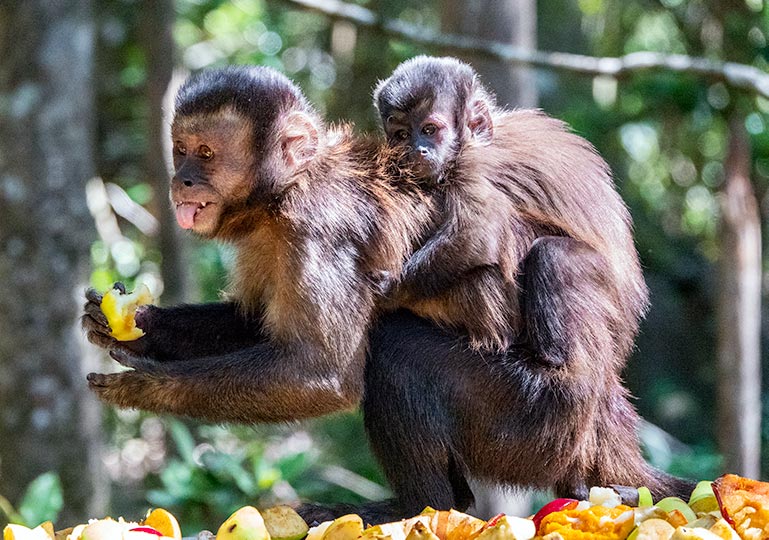
8. Red-backed Bearded Saki
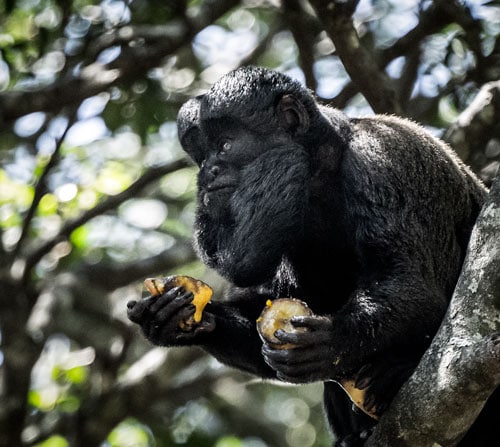
Here’s a red-backed saki with a handful of fruit he’d gathered before escaping into the tree.
No prizes here to see why they are known as bearded monkeys. Strange-looking creatures, but they have a gentle temperament.
Not the cutest monkey in town but rather hip-looking I’d say.
9. Vervet Monkey
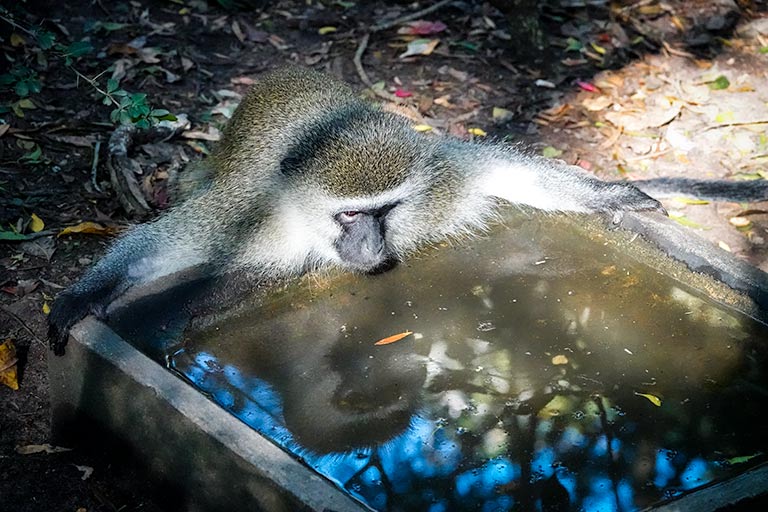

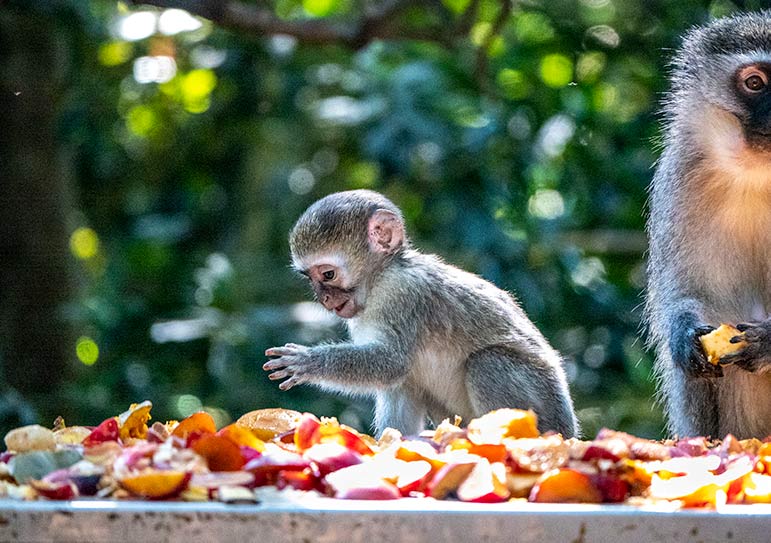
Vervet Monkeys are indigenous to South Africa and we first came across them in the wild at our first campsite in South Africa when we began Overlanding in our 4×4. You need to put all of your food away or they’ll likely come and steal anything you leave out.
As we were watching them, I thought one was holding something blue. He was — but not what I was expecting. The vervet male monkeys have bright blue scrotums with a red penis. Very decorative.
(You can see vervet monkeys kissing and more animal antics in our Kruger animal video )
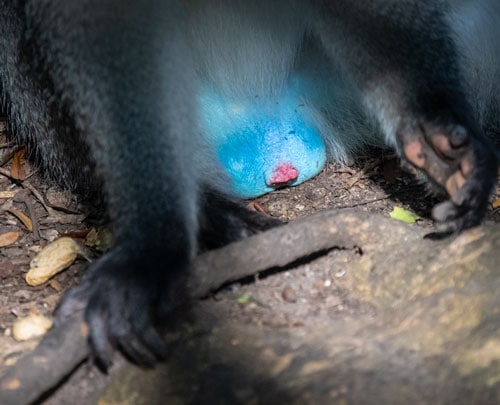
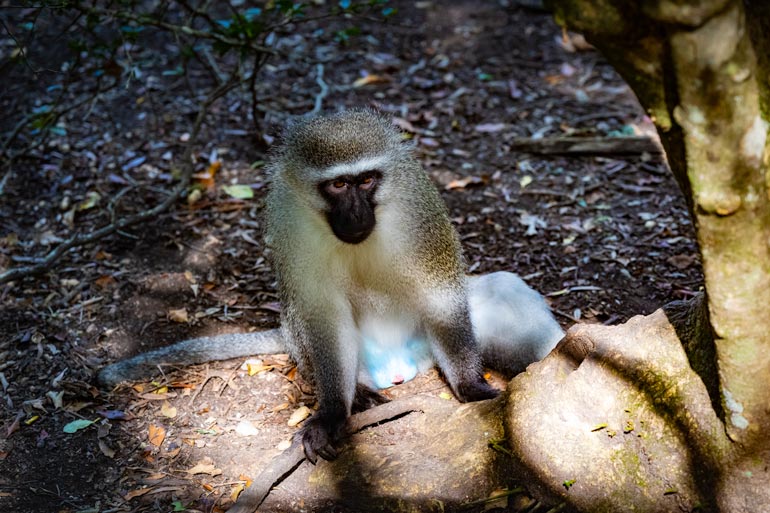
10. White Handed or Lar Gibbon
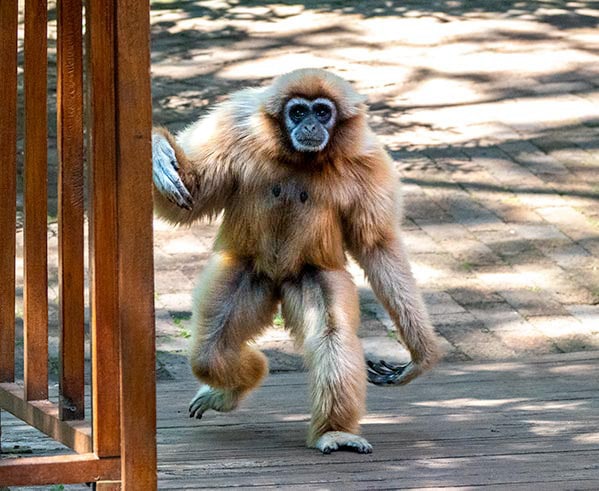
The Lar Gibbon (otherwise known as the White-handed Gibbon), was the first monkey we heard, and then saw, as we arrived at the Viewing Deck at Monkeyland. .
We were immediately surprised and startled when these two cheeky gibbons came out from underneath the picnic bench table right beside us and padded off like two small furry humans with ridiculously long arms.
We hadn’t imagined getting that close and certainly hadn’t expected such an experience before entering the monkey forest.
The Lar Gibbons can swing between trees at 30km per hour! They also ‘sing’, often in duets, through the treetops. Hence, they are known as the ‘singers and swingers’ of Monkeyland.
Monkeyland Practical Information
Admission Prices
Visiting Monkeyland is affordable, with free access to some areas and ticketed entry for guided tours. Special rates are available for combined visits with nearby sanctuaries like Birds of Eden and Jukani Wildlife Centre, allowing for a comprehensive conservation experience.
The cost is free if you just want to go to the viewing deck and the Monkeyland restaurant, but you need to buy a ticket to enter the monkey forest with a guide.
There are varying rates depending on whether you would also like to visit Birds of Eden and/or Jukani Wildlife Centre.
We bought a combination ticket for Monkeyland and Birds of Eden, which cost us 540 ZAR per person. Check here for Monkeyland Plettenberg Bay’s current rates and opening times.
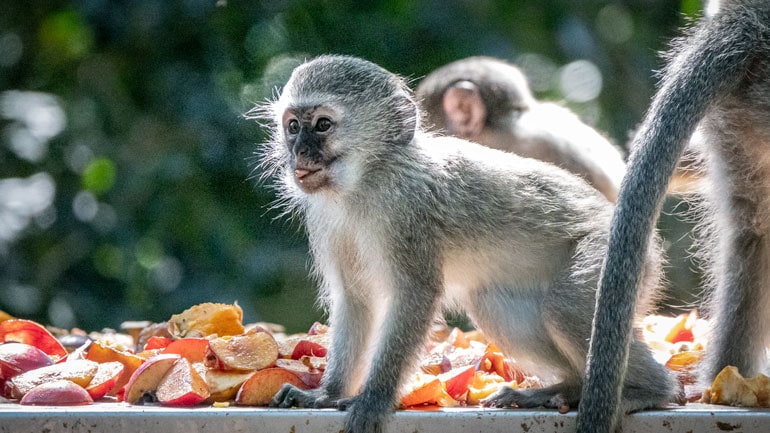
Getting to Monkeyland
Monkeyland is easily accessible from various locations, offering a straightforward journey to the sanctuary:
- From Plettenberg Bay, about 20mins just off the N2.
- From Cape Town – about 6 hours,
- From George – about 1 hrs 45 min
- From Knysna -about 45 min
- From Jeffrey’s Bay – about 1 hour 30 min
Where is Monkeyland Plettenberg Bay?
Address: Portion 11 & 12 of Kirbywood Farm, The Crags, Plettenberg Bay, 6602, South Africa
Is it Worth Visiting Monkeyland? … That’s a Wrap
Absolutely. Monkeyland offers more than just a chance to see exotic animals; it provides educational insights, supports important conservation work, and offers a unique opportunity to witness animals in a setting that closely mimics their natural habitats.
Whether you’re a wildlife enthusiast, a family looking for an educational outing, or a photographer keen to capture nature, Monkeyland promises a rewarding experience.
We hope this guide has helped you plan your visit to Monkeyland Plettenberg Bay. If you have any questions or would like to share your experiences, please reach out or leave a comment below.
We love hearing from fellow wildlife advocates and visitors!
Read more:
- Kruger National Park Animals – A World of Beauty and Brutality
- Ouzoud Falls Monkeys, Morocco
- Monkey Forest Rocamadour France
Planning Your Travels?
These are the travel resources we recommend and use when planning our trips.
- 🚘 Car Hire: We use DiscoverCars.com
- Motorhome/Campervan Rental: We highly recommend the Motorhome Republic
- 🪪 Order your International Driver’s Licence online here
- 🛏 Book Accommodation: We use Booking.com to find accommodation that suits our budget
- 🐶 Pet Sitting/Pet Sitters: Check Out TrustedHousesitters here (Use our Discount code: LIFEJOURNEY25 for 25% off. )
- Activities and Experiences: Get Your Guide and Viator
- Travel Insurance: Safetywing or World Nomads
- 🥾 Travel Gear and Accessories: Check out our top picks here — Lifejourney4two page on Amazon
For a more thorough list, visit our Travel Resources page here.

